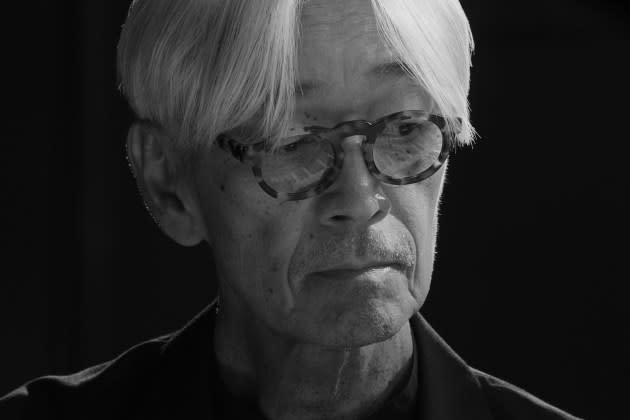‘Ryuichi Sakamoto: Opus’ Review: The ‘Last Emperor’ Composer Gives a Glorious Final Performance

To capture the breadth and depth of the musical career of Japanese composer and recording artist Ryuichi Sakamoto seems impossible, but somehow “Ryuichi Sakamoto: Opus” almost accomplishes this herculean challenge. A document of Sakamoto’s final performance before his death from cancer last March, the film provides no commentary or context for the enormity of his body of work, yet somehow encompasses it all as he performs a curated set list in a Japanese recording studio for an audience of one — himself. Far more than a showcase of his talent and productivity, “Ryuichi Sakamoto: Opus” lets Sakamoto deliver an elegy, and in the process, an autobiography of his creative journey, as captured through the precision and poetry of director Neo Sora’s camera.
Working from a set list personally selected by Sakamoto from his discography, Sora — Sakamoto’s son — recorded his subject’s performances over the span of a week, utilizing lighting setups that would mark a transition from “morning” to “night” in the studio when edited together in the final film. Far from simply collecting the best or most technically precise of these performances, Sora focuses on Sakamoto’s emotions during each song, including the moments in which he made mistakes or worked through the new or different renditions he hoped to create for many of his most famous works. Sakamoto definitely does not refrain from “playing the hits,” so to speak, but the way he plays them results in a new experience, no matter how familiar you may be with their previous iterations.
More from Variety
Among the scores or songs included are cues from “The Last Emperor,” “The Sheltering Sky” and “Merry Christmas, Mr. Lawrence,” as well as material from his days as a member of pioneering electronic group Yellow Magic Orchestra and his later experimental collaborations with Alva Noto. Sora, working with cinematographer Bill Kirstein, shoots in a stark black-and-white 4K format that captures not only the thoughtful deliberation in every one of his movements, but every white follicle dangling over his eyes as he navigates the complexity of his compositions. The images evoke less the soft-lit dreaminess of his 1987 cover for “Neo Geo” than its more starkly decorated 1989 follow-up “Beauty,” while capturing his environment with a mesmerizing architectural precision that seems to transform in response to his music.
Working in concert with these images is an equal clarity of the sound captured, thanks to a recording studio Sakamoto selected because he consider it to have “the finest acoustics in Japan.” Whether or not he’s right, it’s hard to imagine a space that sounds better — and one that does more justice to the performer’s foundational work as a composer. On one hand, it would seem to undercut the work that Sakamoto has done over the years to strip down some of these cues to nothing more than a piece played without accompaniment on a piano; on his 2017 album “Async,” the opening track “Andata” quickly hums, buzzes and spirals off from its piano intro into more discordant territory with an organ and other instruments, for example. But the way that he interprets them, alone in that room with his creativity, only exposes the purity of the melodies he creates that leads to their resulting power.
At the same time, the technological virtuosity used to record Sakamoto reveals the unique expressiveness of the piano beneath his fingers. Notwithstanding the warmth of the piano and the bittersweet romance that weaves through so much of his work, the sound design allows the audience to understand not just the notes as he plays them but their echo, reverberation or fade. Or the linger of a note until he ceases it with a lift of his elegant, slender finger from the key. It’s all startlingly intimate — not simply the sight of him conducting with one hand while playing with the other, or light undulating around him as he peers at a music sheet, but when he plays through his frustration at not quite capturing a sequence of notes, or arrives at a tempo he’s aiming for.
Reflecting his aptitude for entertaining a crowd, Sakamoto saves his most famous pieces for closer to the end, and he gives them a gravitas that underscores the fact that this would very possibly be the final time he would ever perform them. “Merry Christmas, Mr. Lawrence” and “The Last Emperor” are more than award-winning scores; they’re pieces that have become synonymous with his musical voice, and even in his body language he treats them reverently, as if cradling loved ones. Sometimes enjoying his music and sometimes in deep concentration as he wrestles with his compositions, Sakamoto embraced the opportunity Sora gave him to gather together the ones that meant the most, as both a reminder of what he did and what he went through to bring them to life.
Not long after a sequence in which he performs a prepared piano, he finishes, appropriately, with “Opus,” from his 1999 solo piano album “BTTB.” The track’s lilting melody leads the camera to a final shot of the piano playing without him — mirroring his notes as well as the intense feeling that comes with them. It’s a sad conclusion to “Ryuichi Sakamoto: Opus,” but also a reminder that his music lives vividly on. Neo Sora gave Sakamoto his final wish, but it’s a gift to the world — both commemorating an incredible life and career and chronicling a performance rich and sophisticated enough to inspire dozens more.
Best of Variety
Sign up for Variety’s Newsletter. For the latest news, follow us on Facebook, Twitter, and Instagram.